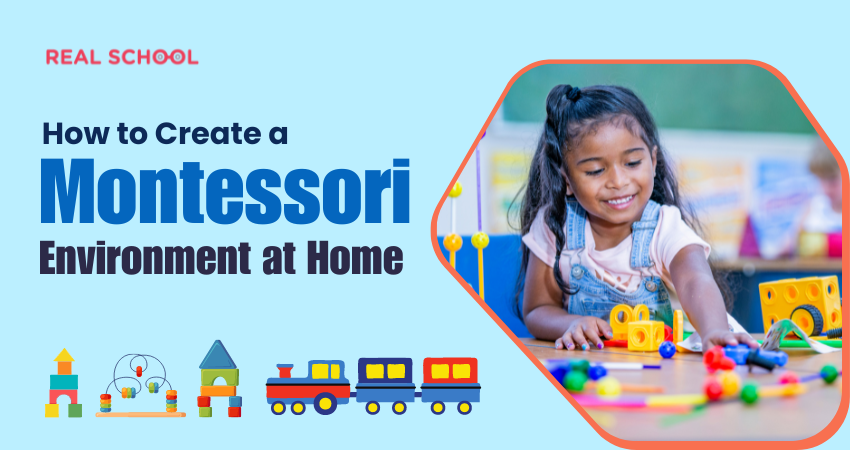The Montessori method of education, renowned for its child-centered approach and emphasis on hands-on learning, has captured the hearts of parents and educators around the world. The beauty of Montessori principles lies in their adaptability beyond the classroom, allowing parents to create a Montessori-inspired environment at home. By fostering independence, curiosity, and a love for learning, parents can nurture their child’s holistic development within the comfort of their own space. In this article, we will explore the steps to create a Montessori environment at home, the key components of this approach, and its lasting benefits.
Understanding the Montessori Philosophy:
Central to the Montessori philosophy is the belief in the child’s innate ability to learn and explore. Dr. Maria Montessori’s principles focus on creating a prepared environment that encourages self-directed learning, hands-on exploration, and respect for the child’s individual pace of development. Translating these principles into a home environment can provide children with a solid foundation for lifelong learning.
Also Read: Why Montessori Schools Are Ideal for Early Childhood Education
Key Components of a Montessori Environment at Home:
Prepared Environment: A Montessori environment at home begins with setting up a space that is organized, accessible, and inviting. Arrange materials and activities on low shelves, allowing your child to independently choose what to engage with. Consider baskets, trays, and containers to keep items neatly arranged.
Child-Centered Approach: Place your child’s needs and interests at the forefront. Observe their preferences and passions, and adjust the environment accordingly. Whether it’s art, science, or practical life skills, provide opportunities for exploration in areas that resonate with your child.
Hands-On Learning Materials: Incorporate Montessori-approved learning materials that encourage sensory exploration and skill development. From puzzles and building blocks to counting beads and language cards, these materials provide a tactile and engaging way for children to learn.
Promote Independence: A core principle of Montessori education is fostering independence. Arrange items in a way that your child can access them without constant assistance. Provide child-sized furniture, utensils, and tools to enable your child to perform daily tasks independently.
Natural and Open-Ended Toys: Opt for toys that encourage creativity and imagination. Open-ended toys, such as wooden blocks, play silks, and nature-inspired materials, allow children to use their imagination and invent their own games and scenarios.
Freedom of Choice: Offer your child choices within reasonable limits. Whether it’s selecting an activity, deciding what to wear, or preparing a snack, these choices empower children and build decision-making skills.
Order and Routine: Establish a sense of order and routine in your home. Consistent routines help children feel secure and understand what to expect, promoting a sense of autonomy and responsibility.
Practical Life Activities: Incorporate practical life activities that promote fine motor skills and self-care. Children can participate in tasks like pouring, folding, and cleaning, which not only develop skills but also instill a sense of responsibility.
Steps to Create a Montessori Environment at Home:
Observe Your Child: Take time to observe your child’s interests, preferences, and developmental stage. This insight will guide your decisions in creating a personalized environment.
Declutter and Simplify: Remove unnecessary clutter and distractions. A simplified environment enhances focus and engagement.
Set Up Inviting Spaces: Designate spaces for various activities, such as a reading corner, art station, or practical life area. Each space should be comfortable and visually appealing.
Select Appropriate Materials: Invest in high-quality, age-appropriate Montessori materials that align with your child’s interests and learning objectives.
Rotate Materials: To prevent overwhelming your child, consider rotating materials every few weeks. This keeps the environment fresh and maintains your child’s enthusiasm.
Encourage Self-Correction: Choose materials that allow for self-correction. This empowers your child to identify and learn from mistakes independently.
Involve Your Child: Involve your child in setting up the environment. Discuss the purpose of each area and how they can use it to explore and learn.
Also Read: What is Montessori Education?
Benefits of a Montessori Environment at Home:
Promotes Independence: By encouraging autonomy and self-directed learning, a Montessori environment at home fosters independence and decision-making skills.
Nurtures Curiosity: The hands-on, open-ended materials in a Montessori environment ignite curiosity and a love for learning.
Builds Confidence: Allowing your child to master tasks and skills independently builds self-confidence and a sense of accomplishment.
Develops Concentration: The focused, self-paced activities in a Montessori environment cultivate concentration and attention span.
Enhances Life Skills: Practical life activities teach essential life skills, from pouring liquids to buttoning clothes, that contribute to a child’s sense of competence.
Encourages Respect: A Montessori environment teaches respect for oneself, others, and the environment through care of materials and consideration for shared spaces.
Conclusion: Creating a Montessori environment at home is an investment in your child’s holistic development. By embracing principles of independence, hands-on learning, and a prepared environment, parents can lay the groundwork for a lifelong love of learning, critical thinking, and a strong sense of self. The beauty of the Montessori approach lies in its adaptability; it empowers parents to create a nurturing space that respects their child’s individuality and paves the way for a future of exploration, growth, and success.







